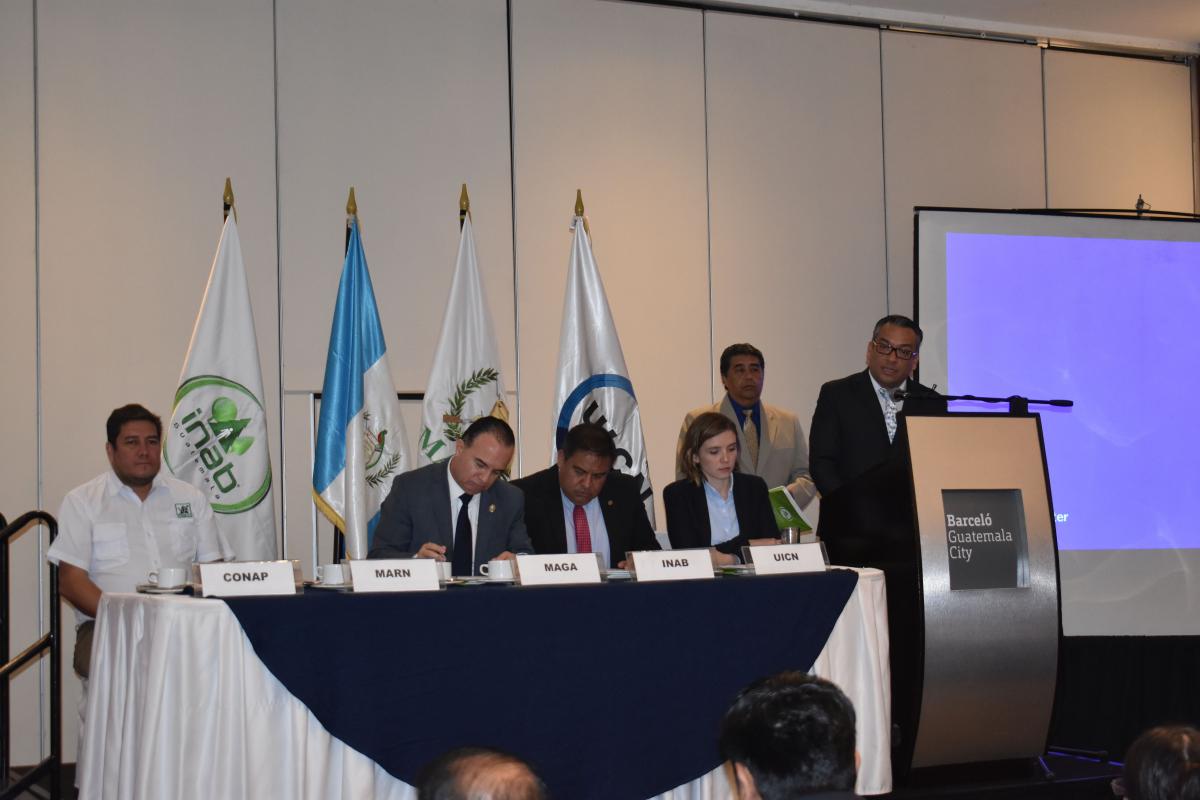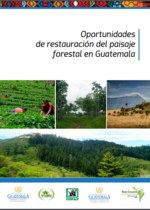Guatemala charts course for restoration
Guatemala unveils the results of a national assessment of restoration opportunities that will guide the implementation of their 1.2 million hectare Bonn Challenge pledge.

Photo: IUCN / Adriana Vidal
November 8, 2018: Representatives from Guatemala’s Ministry of Environment and Natural Resources (MARN), Ministry of Agriculture, Livestock and Nutrition (MAGA), National Council of Natural Protected Areas (CONAP) and the National Institute of Forests (INAB) were joined at the Opportunities for Forest Landscape Restoration Report launch by more than 40 members of Guatemala’s National Roundtable on Forest Landscape Restoration – a critical mechanism for gathering stakeholder insight into how and where restoration should take place in the country.
 Photo: Ministerio de Ambiente y Recursos Naturales de Guatemala (MARN)
Photo: Ministerio de Ambiente y Recursos Naturales de Guatemala (MARN)
MARN’s Vice Minister for Environment, Mr. Magner Estrada, echoed that restoration can bring back the ecological integrity of landscapes, safeguard the survival of species and habitats, and usher in sustainable economic and social benefits for all. “We remain confident that initiatives to bring economic development led by the private sector can be successful if implemented coherently with the government vision to achieve the country’s restoration goals,” Vice Minister Estrada said.
Speakers acknowledged the significance of Guatemala’s ecosystem and forest landscape restoration (FLR) efforts internationally as Guatemala has received recognition for joining the Bonn Challenge, a global effort to bring 150 million hectares into restoration by 2020 and 350 million hectares by 2030.
The implementation of Guatemala’s pledge to the Bonn Challenge has been identified as a vehicle for executing many national targets that respond to the SDGs, the Aichi Biodiversity Targets and the Paris Agreement. Participants shared the hopeful view that landscape restoration is an attainable goal as the country follows through on a sustainable approach for the implementation of policies across sectors.
Ursula Parrilla, IUCN’s Guatemala Office Coordinator added, “We are excited to witness that political will has gone hand in hand with technical evidence and public resources in order to achieve the approval of the first climate change adaptation project in Guatemala under the Green Climate Fund, with FLR included as a key strategy. This project will benefit more than 130,000 people in the highlands, building much-needed resilience to climate change. The analysis included in the Opportunities for Forest Landscape Restoration Report has been instrumental in identifying the areas best suited for restoration, and how to operationalise private and public investments. The implementation of the project will serve as a live source of learning where field evidence will be retrofitted into decision-making processes for public policy and investment decisions.”
INAB’s Director, Rony Granados, highlighted that the report – which supports the operationalisation of the 2015 National Strategy for Forest Landscape Restoration – provides key information for decision makers as it includes economic and financial analysis for the implementation of restoration actions. “A sound cost-benefit analysis coupled with information on the availability of public funds coming from PROBOSQUE facilitates the construction of a vision for scaled up restoration action in degraded and deforested areas.”
Also see Value for money: Guatemala's forest landscape restoration
Guatemala is now looking at how to take this country-level data and adapt it to specific local sites. The Guatemalan government, steered by the National Roundtable on Forest Landscape Restoration, and with the support of IUCN, will continue this work, aiming to generate business plans and updating the investment portfolio for landscape restoration action. It is expected that these efforts will translate into a growing interest of the private sector to engage with profitable activities that support FLR.
—Written by Adriana Vidal, Ursula Parrilla and Orsibal Ramirez



